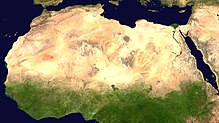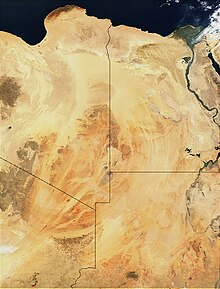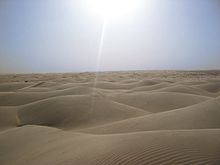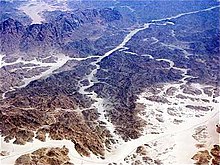Sahara

Oasis in the Sahara (Libya)
|
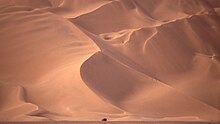
All-terrain vehicle in front of a large dune in the western Great Erg in Algeria
|
The Sahara has over nine million square kilometers, the largest dry desert earth. This corresponds to just under the area of the entire USA or about 26 times the area of Germany . It extends from the African Atlantic coast to the coast of the Red Sea and forms an area of 4500 to 5500 kilometers west-east and 1500 to 2000 kilometers north-south. It belongs to the tropic deserts .
The Sahara is mostly a stone or rock desert ( Hammada ) or a gravel or rubble desert ( Serir ); the better known sandy desert ( Erg ) only makes up about 20 percent of the area. According to a 2018 study, the Sahara has expanded by around 10 percent since the 1920s, a process known as desertification .
etymology
The Arabic word for "desert" is sahra ' (صحراء, DMG ṣaḥrāʾ ) with the emphasis on the last syllable, a plural form of it, ie "deserts", is sahara (صحارى, DMG ṣaḥārā ) with an emphasis on the middle syllable, which is long. Apart from the fact that both the “ ṣ ” and the “ ḥ ” are special Semitic sounds that are very difficult for Europeans to pronounce, this plural form corresponds exactly to the German word Sahara. The replacement of “ṣ” by the common “s” and of “ḥ” by the common “h” is the normal case if the corresponding Semitic sounds are not mastered.
In Arabic it becomes the Sahara الصحراء الكبرى, DMG aṣ-ṣaḥrāʾ al-kubrā , called "the great desert". Sometimes you can also find the nameبحر بلا ماء, DMG baḥr bilā māʾ , "sea without water" (cf. Sahel for "shore").
The ancient Romans called the land south of Carthage Terra deserta , meaning "abandoned land". In the Middle Ages , the Sahara was simply called the Great Desert . It was not until the 19th century that the name Sahara caught on.
geography
location
The Sahara is located in northern Africa. It extends from the Atlantic coast to the coast of the Red Sea and forms an approximately trapezoid from 4500 to 5500 km west-east and 1500 to 2000 km north-south. In Egypt it is interrupted by the river oasis of the Nile . In the north are the Maghreb states of Morocco (including the annexed territory of Western Sahara ), Algeria , Tunisia and Libya . To the south of it belong the states of Mauritania , Mali , Niger , Chad and Sudan to the Sahel zone .
geology
Researchers conclude from the location of different rock layers that in this desert dry and wet phases alternated several times over the course of several million years. Since the Arabian plate closed the sea connection between Tethys and what is now the Indian Ocean seven million years ago, an atmospheric circulation has been created, which favors desert conditions in the Sahara. By dating of fossils in soil samples from the Chad Basin of detection was that the Sahara was already seven million years ago, at least temporarily a desert. Even under these analyzed soil layers there were still further and older sandstone layers , which could only have been created by wind drifts under desert conditions. In the pluvial times , large parts of the Sahara were water-rich and green, as is shown by numerous rock paintings from the later periods and the dry river beds ( wadis ) that often extend from the mountains and are over 1000 km long . Research by the University of Illinois in Chicago in 2004 found that the groundwater under Egypt and Libya is up to a million years old. It flows slowly northward in an underground system from Nubia at a rate of only one to two meters per year.
In addition, the desert is located in the subtropical high pressure belt , so it is a tropic desert . Since the descending air movements cause the clouds to dissolve, light and thermal radiation can be radiated in and out unhindered.
The Sahara has some mountain ranges, such as the Hoggar Mountains and the Tibesti Mountains . The highest point is the Emi Koussi in the Tibesti with 3415 m above sea level . There are also some large meteorite impact craters in the Sahara. The largest crater found so far is the Kebira crater , it has a diameter of 31 km.
climate
The Sahara generally has an arid climate . The central regions of the Sahara are under the influence of the northeast trade wind Harmattan all year round , which, however, brings little rainfall. The southwest and south-central regions of the Sahara are subject to the seasonal changes caused by the interaction between the harmattan and the West African monsoons , while the northwestern regions are characterized by the seasonal changes in the Mediterranean climate .
Extreme temperature fluctuations can occur during the day. The average maximum daily temperatures in summer are around 30 ° C, the maximum values often exceed 37 ° C. In the winter months, the temperature can drop below freezing point at night, ground frost can occur briefly and snow can also fall at high altitudes . After such a weather constellation had not occurred for 37 years, it snowed again in the Algerian part of the Sahara on December 19, 2016 for the first time since February 18, 1979.
The average amount of precipitation in the Sahara is around 45 mm, but there are regional extremes and large differences. With only a few millimeters of precipitation per year, some regions in southern Libya and Egypt are almost as dry as the Atacama Desert , which is considered the driest region on earth. In general, the high mountains of the Sahara receive more precipitation than the subsidence areas surrounding them. In the Tibesti, up to 600 mm, in the Aïr up to 150 mm, annual precipitation falls , whereby these regions form their own biomes . The air saturation deficit is generally very high, the water evaporation rate in the area of the Ounianga lakes can be up to 6330 mm.
During the peak of the West African monsoons in July and August, around 100 to 200 mm of precipitation falls in the southern Sahara. This creates a grass savannah, which is followed by the actual Sahel zone . For some years it does not rain at all in some regions of the Sahara. In other years, the West African monsoon skips the Sahara and brings torrential rains in the region.
The only river that crosses the Sahara is the Nile . It is an alien river .
The influence of the Sahara on the global climate has only been partially clarified. In particular, the aerosols from the Sahara seem to be a major source of weather and climate-determining aerosols, alongside volcanic eruptions. It is scientifically proven that the emissions have an influence on the precipitation regime in the Sahel and Sudan zones . The Bodélé Depression and the Djado Plateau , for example, are considered very productive aerosol mobilization areas .
Natural resources
Mineral resources can also be found in the Sahara. Rich oil and gas fields have been discovered in the Algerian and Libyan Sahara . Other mineral resources are: salt , coal , copper , gold , manganese , iron , uranium , lead , tungsten , titanium , tin and phosphates .
population
The small indigenous population consists mainly of Arabs , Berbers, and Moors . There are also small groups such as the Tubu (also Tibbu ) and Tuareg . In addition to livestock farming, the Trans-Saharan trade was an essential livelihood for these population groups, also known as Yallas , until the 19th century . The Tuaregs are numerically the largest in the Sahara. 60 percent of the Saharan people are settled oasis farmers , 40 percent nomads and semi-nomads . Larger settlements are found mainly on the northern edge of the Algerian Sahara. New settlements have formed in the oil and gas producing areas of Algeria and central Libya. In the west and in the Libyan desert , large areas are deserted.
fauna
Of the 14 large vertebrate species that inhabited the gigantic space in historical times, four had already disappeared for good in 2013, including the saber antelope . In addition, most of the species have disappeared from 90% of their range, including the Mendes antelope , the Dama gazelle and the cheetah , more precisely the subspecies Acinonyx jubatus hecki .
history
In 2017, Madelaine Böhme and colleagues found the earliest evidence of a dry phase in the layers of the Graecopithecus freybergi in Greece, which are 7.2 million years old. It was reddish, salty fly dust, typical of the Sahara, with an amount that is about ten times higher than the current level of fly ash from the Sahara in Greece and more in line with the situation in today's Sahel zone .
According to a study published in 2009, the Sahara was greened three times for a few thousand years in the past 200,000 years: first 120,000 to 110,000 years ago, then again 50,000 to 45,000 years ago and most recently during the so-called "green Sahara period": Als sich Towards the end of the last Ice Age, the tropics again shifted 800 kilometers to the north, the Sahara, which had previously been a desert as it is today, turned back into a fertile savannah landscape . Around 14000 BC The last humid period began first in West Africa; in East Africa it did not begin until around 8000 BC. A. This climate change was followed by hunters and gatherers from the south. The Neolithic Revolution took hold of the Sahara in around the 6th millennium BC. BC , when the inhabitants of the region started farming. A city culture like that on the rivers Nile , Euphrates and Tigris is not known. The first rock carvings in the Sahara were made around 10,000 BC. Chr.
Between 4000 and 3500 BC BC the dry phase began in the Sahara, which led to the displacement of life from the desert within a few centuries or decades. As well as the east from around 3300 BC. Slowly dried up in BC, the people withdrew to the south or into the fertile Nile valley . From around 3200/3100 BC The enigmatic Clayton rings found in the eastern Sahara date from the 4th century BC, the predynastic period of ancient Egypt . In the 2nd millennium BC Chr. Began the horses time so named because from that time horses prevail in the motives of cave painting. As in Egypt, Anatolia and the Aegean Sea , in the 16th century BC Chr. The "silver bullet" to the Bronze Age introduced the chariot . Pharaoh Ramses III. lists 92 chariots and 184 horses as the booty of his Libya campaign.
With the drying up of the Sahara came the slow decline of agriculture and livestock. With the Assyrian conquest of Egypt in the 7th century BC Chr. Came the camel to Africa and replaced the horse as the main beast of burden from. It was used on a larger scale at the latest since the Ptolemaic times .
In the center of the Sahara arose from the 5th century BC. The empire of the Garamanten , which was based on a successful oasis economy on the one hand, but whose great wealth was based on trade between Africa and the Mediterranean, first with the Greeks via Cyrene , then with the Romans via Leptis Magna . The decline of the Western Roman Empire largely halted this trade, and the depletion of groundwater supplies restricted the oasis economy. But the end came with the conquest by the Muslim Arabs .
The exploration and conquest of the Sahara
The earliest recorded reports about the Sahara include parts of Herodotus' histories (5th century BC).
From the end of the 18th century, the Sahara moved into the focus of European science and export trade. The French René Caillié traveled from Boké on the Guinea coast to Timbuktu in 1827/28 and then crossed the western Sahara to Tangier . He was the first European to return alive from Timbuktu . His trip leading up to the French occupation of Algeria (since 1830) was interpreted as part of a race between the French and British to conquer Africa, although he personally never claimed this role.
Above all, the British were looking for secure access to the markets of inner Africa, where they expected enormous sales opportunities for their finished products, but also important sources of raw materials. Therefore, the exploration of the Sahara seemed to them less important than the access to the interior via the Nile and Niger and the fertile lands of Central and South Africa. The French, on the other hand, had been advancing eastward from Senegal towards the upper reaches of the Nile and south-east towards the Ivory Coast , where they quickly became embroiled in armed conflicts since the late 1870s .
The most important of the British Sahara expeditions was led by the missionary James Richardson , who died in Sudan in 1851. His successor as expedition leader was his companion, the German geographer and archaeologist Heinrich Barth (1821–1865), whose five-volume, 3500-page travel book is the most important source for ethnology in the Sahara region in the 19th century and is still used today for science is used profitably. Barth's research among the Tuareg of the northern Sahara was continued by the French Henri Duveyrier (1840-1892). As one of the first explorers, Gerhard Rohlfs also crossed the Sahara and the south-bordering savannas from Tripoli to the Gulf of Guinea between 1865 and 1867 .
The Sahara in literature
The Sahara is the setting for numerous novels and other literary works, many of which are part of European exoticism or the adventure novel genre (examples: Ouida : Under Two Flags , 1867; EM Hull: Der Scheich , 1919; Elleston Trevor : The Flight of the Phoenix , 1964; Desmond Bagley : Flyaway , 1978; Paulo Coelho : The Alchemist , 1988; Clive Cussler : Sahara , 1992; David W. Ball : Empire of Sand , 1999).
Authors such as Paul Bowles ( The Sheltering Sky , 1949), Albert Camus ( La Femme adultère , 1957), Brion Gysin ( The Process , 1969), Alberto Vázquez-Figueroa ( Tuareg , 1980) and Ibrahim al-Koni ( Goldstaub , 1990) Those who were well acquainted with the Sahara as locals or travelers have also contributed highly literary resources to this topic. Other important Sahara novels are Désert (1980) by the Franco-Mauritian Nobel Prize for Literature Jean-Marie Gustave Le Clézio and Michael Ondaatjes The English Patient (1992).
See also
- Tamanrasset (oasis in Algeria)
literature
- Ralph A. Austen: Sahara. Exchange of ideas and goods for a thousand years (= Wagenbach's pocket books 716). Translated from the English by Matthias Wolf. Klaus Wagenbach Verlag, Berlin 2012, ISBN 978-3-8031-2716-7 .
- Fayez Alaily: The heart of the Sahara, the driest area on earth. Climate, geology, hydrology, ecology, soil sociology, soil genesis and land use suitability. 1st edition. Projekt-Verlag Cornelius, Halle 2008, ISBN 978-3-86634-603-1 .
- Barbara E. Barich: People, water, and grain. The beginnings of domestication in the Sahara and the Nile valley. L'Erma di Bretschneider, Rome 1998, ISBN 88-8265-017-0 .
- Jean Bisson: Mythes et réalités d'un désert convoité: Le Sahara. L'Harmattan, Paris 2003.
- Albert Adu Boahen : Britain, the Sahara and the Western Sudan, 1788–1861. Oxford 1964 (most important historical single study on the history of Sahara research).
- Alain Drajesco-Joffé: La vie sauvage au Sahara. Delachaux et Niestlé, Neuchâtel 1993, ISBN 2-603-00871-4 .
- Fabrizio Mori: The great civilizations of the ancient Sahara. L'Erma di Bretscheider, Rome 1998, ISBN 88-7062-971-6 .
- Heinrich Schiffers : The Sahara. Developments in a desert continent. Borntraeger, Kiel 1980, ISBN 3-554-60106-3 .
- The desert . Geo books published by Gruner AG + Co, Hamburg, ISBN 3-570-01665-X .
- Sahara: sea without water. Geo 4/1977, pages 82-108. Publisher Gruner + Jahr, Hamburg.
- Uwe George : Sahara: The lost sea. In: Geo-Magazin. Hamburg 1980,1, pp. 32-60. Informative experience report. ISSN 0342-8311 .
Historical travel reports
- Heinrich Barth: Travels and discoveries in North and Central Africa. Gotha 1857-1858, 5 vols.
- Heinrich Barth: In the saddle through North and Central Africa, 1849–1855. Stuttgart 2007 (short version of the five-volume travel book).
- Gustav Nachtigal : Sahara and Sudan. Berlin, Leipzig 1879–1889, 3 vols. (Next to Barth's work the most important travelogue about the Sahara).
- Gustav Nachtigal: Tibesti. The discovery of the giant craters and the first crossing of Sudan, 1868–1874. Edited by Heinrich Schiffers . Tübingen / Stuttgart 1987.
- Gerhard Rohlfs : Across Africa. The first crossing of the Sahara from the Mediterranean Sea to the Gulf of Guinea 1865–1867. Thienemann Edition Erdmann, Stuttgart 1984, ISBN 3-522-60580-2 .
Web links
- Flora and Fauna of the Sahara (French)
- Vegetation ecology of tropical and subtropical climates H. Kehl, TU Berlin, Institute for Ecology
- The history of the Sahara - lakes in the sand. An amazing transformation. Bavaria 2. Radio knowledge. Podcast.
Individual evidence
- ↑ New study finds world's largest desert, the Sahara, has grown by 10 percent since 1920. National Science Foundation, March 29, 2018.
- ↑ Hans Wehr : Arabic dictionary for the written language of the present . Otto Harrassowitz, Wiesbaden 1968, p. 459.
- ↑ http://www.nature.com/nature/journal/v513/n7518/full/nature13705.html
- ↑ M. Schuster et al .: The Age of the Sahara Desert. In: Science , Volume 311, 2006, p. 821, doi: 10.1126 / science.1120161 .
- ↑ For more on fossil water use in the northeastern Sahara, see Libyan Desert # Hydrogeology
- ↑ Sahara Climate infoplease.com (English)
- ^ "Let it snow" - Le Sahara sous la neige pour la première fois depuis 37 ans (French) on vanityfair.fr, accessed on December 21, 2016.
- ↑ "Boundaries of Lake Chad Region" UNEP publication 8.41 MB PDF format
- ↑ Stefan Kröpelin et al .: Climate-Driven Ecosystem Succession in the Sahara: The Past 6000 Years. In: Science, May 9, 2008 ( PDF, 892 kB ).
- ↑ World Wildlife Fund: Africa - Mauritania, Mali, Algeria, Niger, Chad, Sudan (English).
- ^ West African Monsoon crosses the Sahara desert. (August 2007) by Philip Mulholland (University of Lancaster, UK) (English).
- ↑ The desert floats. 3Sat, hitec
- ↑ C. Flamant, J.-P. Chaboureau, DJ Parker et al .: Airborne observations of the impact of a convective system on the planetary boundary layer thermodynamics and aerosol distribution in the inter-tropical discontinuity region of the West African Monsoon , in: Quarterly Journal of the Royal Meteorological Society 2007; 133: 1175-1189 ( online ).
- ↑ Studies of 21st-century precipitation trends over West Africa (PDF; 906 kB) Author: Leonard M. Druyan Center for Climate Systems Research, Columbia University and NASA / Goddard Institute for Space Studies, New York, NY 10025, USA (English) .
- ↑ SM Durant et al .: Fiddling in biodiversity hotspots while deserts burn? Collapse of the Sahara's megafauna , in: Diversity and Distributions 20 (2013) 114–122.
- ↑ The oldest pre-human may have lived in Europe , University of Tübingen, May 26, 2017
-
↑ Isla S. Castañeda et al .: Wet phases in the Sahara / Sahel region and human migration patterns in North Africa. In: PNAS , Volume 106, No. 48, 2009, pp. 20159–20163, doi: 10.1073 / pnas.0905771106 .
idw-online of November 10, 2009: Humid climatic phases in the Sahara favor the spread of modern humans. - ↑ Martin Claussen; Veronika Gayler: The Greening of the Sahara during the Mid-Holocene: Results of an Interactive Atmosphere-Biome Model. In: Global Ecology and Biogeography Letters , Vol. 6, No. 5, 1997, pp. 369-377, abstract .
- ↑ Stefan Kröpelin et al .: Climate-Driven Ecosystem Succession in the Sahara: The Past 6000 Years. In: Science , Volume 320, No. 5877, 2008, pp. 765-768, doi: 10.1126 / science.1154913
- ↑ Tim Schröder: The desert is green . In: MaxPlanckResearch . No. 4/2011 . Max Planck Society, 2011, ISSN 1616-4172 , p. 81–82 ( digitized version [PDF; 9.1 MB ]).
- ↑ Tim Schröder: The desert is green . In: MaxPlanckResearch . No. 4/2011 . Max Planck Society, 2011, ISSN 1616-4172 , p. 85–86 ( digitized version [PDF; 9.1 MB ]).
- ^ Travel Egypt from the comfort of your armchair. Retrieved January 29, 2018 .
Coordinates: 26 ° N , 13 ° E
